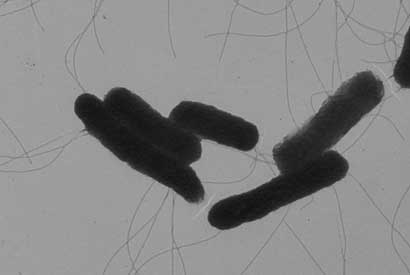Salmonella = Good Health?
We know that salmonella is bad for your health… but Researchers from the UC Berkeley’s School of Public Health have found that a simple reprogramming can actually help to battle the enzymes of other viruses. What was even more amazing that this technique not only treated mice that were infected with cytomegalovirus, but it also worked as an oral solution – not an injection.

Shown is an image of Salmonella bacteria taken by an electron microscope. Researchers at UC Berkeley have turned this foodborne pathogen into an anti-viral delivery agent. (Sangwei Lu image)
Virologist Fenyong Liu and Bacteriologist Sangwei Lu teamed up together to develop this innovative technique. To be published this week in the Proceedings of the National Academy of Sciences journal, their findings included a number of vaccines which include smallpox and polio. It also weakened viruses in the immune system.
According to Liu, this is the first time that anyone has successfully engineered bacteria to treat viral infections. Liu is a Professor at the University of California Berkley’s Division of Infectious Diseases and Vaccinology.
Researchers said that Salmonella was an appealing choice as it had evolved to survive the human digestive system. As a result, it can be swallowed rather than inhaled or injected. Lu, who is an associate adjunct professor, said that “This is the first gene therapy treatment for viral infection that can be taken by mouth, which is far more convenient to administer than an injection. Moreover, there is already an attenuated strain of Salmonella with a decent track record for safety in humans since it is now used in the vaccine for typhoid (a disease caused by Salmonella Typhi).”
Scientific researchers know that ribozymes which are enzymes that can target and cut specific RNA molecules can also be used to deactivate a pathogens genes. In order to do the work, these ribozymes first need to get into the cells. Salmonella is great at invading cels so the researchers found away to use the bacteria for the Rnase Pribozyme which could aid in stopping the gene activity for cytomegalovirus (CMV).
CMV is in the same family of herpes viruses, which can cause chickenpox, cold sores, and mononucleosis. These infections are generally mild amongst healthy individuals, but those who are low immune systems and are infected may die. Newborns can have mental retardation as well due to CMV.
Previous research conducted by Liu and Lu showed that salmonella could effectively sneak into the anti-viral ribozomes that were infected with human CMV. This reduced the viral load of the cell cultures. As a safety measure, researchers took the attenuated salmonella strain to mutate it into a gene to replicate bacteria. This mutant strain did not make the mice sick.
After doing this, the researchers cloned the anti-viral ribozymes into plasmids. Once the mice were infected with CMV, they were given the oral dose of ribozyme-carrying Salmonella. It was found that not only did all of the mice survive, but they also had a lower viral load.
The duo pointed out that by using bacteria instead of viruses has a number of advantages. These include replication, safety, ease, and cost. There is also a potential for developing this technique for other gene-targeting therapeutics.
Other authors on this paper include the lead author, Yong Bai, and Hao Gong. Both are post-doctoral researchers in infectious diseases. There was also Hongjian Li who was a former post-doctoral researcher in infectious diseases, as well as Gia-Phong Vu who is a graduate student in comparative biology. Part of this study was supported by the National Institutes of Health and the US Department of Agriculture.


